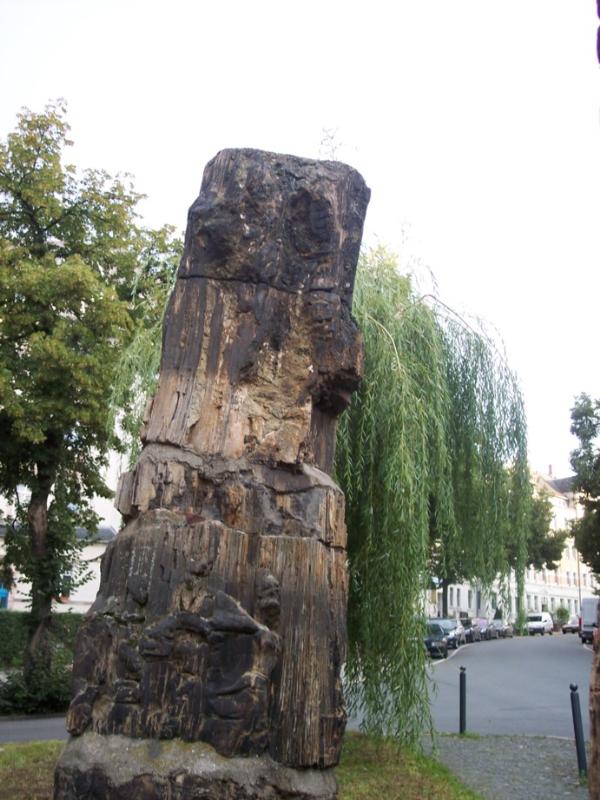Ein versteinerter Wald ist ein fossiler Wald, dessen Bestandteile durch den Prozess der Verkieselung (Einbau von Kieselsäure) umgebaut wurden und so erhalten blieben. Manche nennen das auch Dendrolith, versteinertes Holz oder versteinerter Baum.
Entsprechende Objekte zeigen oft eine so deutliche Struktur. Mit Hilfe eines Mikroskops kann man sogar noch die Pflanzenart erkennen.
Versteinerter Wälder findet ihr auch in Arizona (Petrified-Forest-Nationalpark), Namibia (Namibia), Kalifornien (Calistoga), Yellowstone-Nationalpark, Lesbos (zwischen Sigri und Antissa) und eben hier bei uns in Chemnitz
Der Versteinerte Wald von Chemnitz ist eine der bedeutendsten Sehenswürdigkeiten der Stadt.
Im Chemnitzer Stadtteil Hilbersdorf stößt man seit dem Erstfund 1737 bei Schachtungsarbeiten immer wieder auf die verkieselten Hölzer. Der bei Chemnitz wohnende Edelstein-Inspektor David Frenzel (1691 - 1772) ließ bereits Mitte des 18.Jh zahlreiche Kieselhölzer bergen und stellte daraus Schmucksteine her. Der Hilbersdorfer Bauunternehmer Güldner vermachte später dem Chemnitzer König-Albert-Museum viele versteinerte Stämme. Und der damalige Direktor dieses Museums, Prof. Sterzel, übernahm die Untersuchung der Fundstücke. Daher heißt auch das Museum in der Stadt nach ihm (Sterzeleanum).
Die Entstehung der Kieselhölzer stehen im Zusammenhang mit dem Ausbruch des Zeisigwald-Vulkans vor ca. 290 Mio. Jahren. Beim Ausbruch wurden die Stämme wie 1980 beim Vulkan Mount St. Helens durch die Eruptions-Druckwelle entwurzelt, abgeknickt und entästet. Die Stämme wurden danach mit 80 bis 100 °C heißen Auswurfmaterialien Pyroklastika des Vulkans bedeckt.
Die meisten der Stämme sind heute im Museum für Naturkunde im Chemnitzer Kulturkaufhaus DAStietz zu bewundern, besonders schön sind dabei die Exemplare mit geschliffener Oberfläche.
Eine kleine Sammlung ist auch an der Zeißstraße zu sehen.
Und das ist eurer Earthcacheaufgabe vor Ort:
1. Wieviel Stämme findest du an den o.g. Earth-Cache – Koordinaten?
2. An wen erinnert die Gedenktafel?
3. Mache (freiwillig) ein Foto vom versteinerten Wald bei den Koordinaten N 50°51.067 / E 012°56.727 (hier sage ich nur Achtung!!!) und mailt es mir zu (bitte nicht beim Log abspeichern) Im Netz kursiert eine Liste mit fertigen Antworten zu diesem Cache. Die kann man natürlich abgreifen und schon hat man den EC-Punkt. Es muss jeder selber wissen, ob er mogelt oder fair cacht und so was nicht braucht. Wer sich gern von solchen Cachern abgrenzen mag, der kommt mit einem selbst gemachten Foto vor Ort aus der Bredouille ganz gut raus - auch wenn es keine Pflicht mehr ist. Daher ist es um so besser, wenn ihr erkennen lassen könnt, dass ihr wirklich vor Ort gewesen seid.
Mailt mir bitte die 2 Antworten + das Foto nur an sennis_letterbox at yahoo.de, vergesst bitte nicht euren Geocachernamen mit anzugeben und wählt in der Mail den Betreff "VW Hilbersdorf" dann geht es bissel flotter und loggt bitte erst, wenn ihr die Freigabe erhaltet. Bitte stellt keine Fotos ins Netz, die die Fragen beantworten könnten
ACHTUNG: Das neue Message Center wird nicht benutzt ! Nutzt bei Kontaktaufnahme, die Send Email Funktion und nicht das Message Center! - Danke!
|

|

|
Petrified wood is a type of fossil: it consists of fossil wood where all the organic materials have been replaced with minerals (most often a silicate, such as quartz), while retaining the original structure of the wood. The petrifaction process occurs underground, when wood becomes buried under sediment. Mineral-rich water flowing through the sediment deposits minerals in the plant's cells and as the plant's lignin and cellulose decay away, a stone mould forms in its place. The wood is preserved due to a lack of oxygen.
Elements such as manganese, iron and copper in the water/mud during the petrification process give petrified wood a variety of color ranges. Pure quartz crystals are colorless, but when contaminants are added to the process the crystals take on a yellow, red or other tint.
Following is a list of contaminating elements and related color hues:
* carbon - black
* cobalt - green/blue
* chromium - green/blue
* copper - green/blue
* iron oxides - red, brown, yellow
* manganese - pink/orange
* manganese oxides - black
Petrified wood can preserve the original structure of the wood in all its detail, down to the microsopic level. Structures such as tree rings and the various tissues are often observed features. Petrified wood has a Mohs hardness of 7, the same as quartz.
Petriefied Woods you can also find in Arizona: (Petrified-Forest-Nationalpark), Namibia (Namibia), Kalifornien (Calistoga), Yellowstone-Nationalpark, Lesbos (zwischen Sigri und Antissa) and of course here in Chemnitz
The petrified forest of Chemnitz is one of the most important objects of interest of the city.
Since the first found 1737 construction workers or geologists find again and again in Hilbersdorf (Chemnitzer district) with pit work the petriefied stems (woods/phyla).The emergence of the flint woods stand in connection with the outbreak of the Zeisigwald volcano forwards approx.. 290 million years. With the outbreak the trunks were disrooted, snapped off (bent) and lost there branch like 1980 with the volcano Mount pc. Helens by the eruption pressure wave. The trunks were covered thereafter with 80 to 100 °C hot ejection materials Pyroklastika of the volcano.
Most of the trunks are to be admired today in the museum for natural history in the Chemnitzer culture department store DAStietz, particularly beautifully are thereby the copies with polished surface. A small collection is to be seen here at the road „Zeißstraße“.
A small collection is to be seen also at the Zeiss road.
And that is your Earthcache-lesson (the educational task) :
1. How many trunks of petrified wood you find on the coordinates of this Earthcache?
2. Of whom does the roll of honour remind?
3. Make a photo of the petrified forest on the coordinates N 50°51.067/E 012°56.727 and mail it also (pleasesend this photo not with the log)
Mail me the 2 answers + the photo only to sennis_letterbox at yahoo.de (no message with message center) and logs please only if you have the release receive. Please no photos place in the geocaching-log, which could answer the questions.